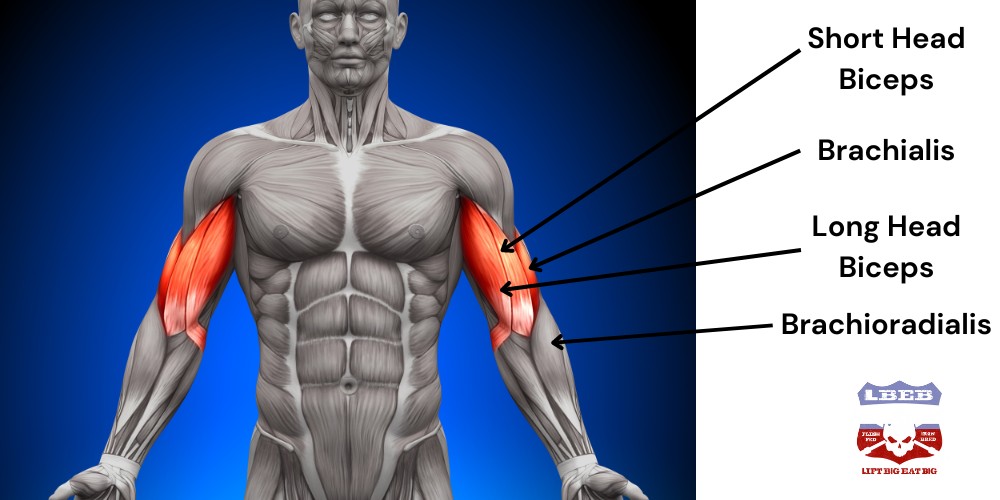The biceps long head is referred to as the muscle that creates the "biceps peak." While the peak is mainly genetic based on muscle insertions and origins, it doesn't hurt to build sleeve-busting biceps. But can we even isolate the long head of the biceps, and would you want to anyway?
Table of Contents
Biceps Anatomy
The biceps brachii consist of two heads:

Both heads originate at the shoulder and insert on the radius bone in the outer forearm [1]. The primary function of the biceps is to flex the elbow and supinate the forearm. They also help flex the shoulder. The biceps brachii elicit the greatest muscle activation when the forearm is supinated.
There are also the brachialis and brachioradialis, which are preferentially activated with different hand positions [2][3]. But we won’t concern ourselves with that now as we are focusing on the biceps long head.
Can You Isolate The Biceps Long Head Over The Short Head?
You can’t completely isolate the biceps long head from the short head. Both heads of the biceps perform elbow flexion and supination. However, you can better target the long head by placing the biceps under stretch using a supinated hand position [4].
While the research may indicate slightly better muscle activation, it won’t make a difference in the grand scheme of training. Further, why would you want to develop one biceps head? When training for big arms, you want complete biceps development.
That encompasses the entire biceps brachii of the short and long heads. Regardless, here are the exercises that will best hit the long head to get bigger biceps.
8 Best Long Head Biceps Exercises
Incline Dumbbell Curls
I love the incline dumbbell curl and often use it at the end of my biceps training. In my opinion, it is best placed at the end because of the extreme stretch. It places the shoulders in an extended position with the elbow behind the body.
Doing this as your first exercise when not adequately warmed up may increase your risk of injury. Plus, it's nice to have a loaded stretch after plenty of training within the normal range of motion. Here's how to do it:
Bayesian Curl
The Bayesian curl is the current trendy biceps exercise because of the long muscle length. I much prefer the incline dumbbell curl for lengthening the biceps, but if you have a cable column, this also works. Here's how to do it:
Barbell Curl
No long head biceps exercise list is complete without the king of biceps exercises—the barbell curl. Huge biceps have been built for decades with this simple exercise. Yet lifters will waste time pumping their biceps with light, fancy movements. Here's how to do it:
Dumbbell Curl
While you don't get the same loading as the barbell curl, your biceps long head still get hammered during the dumbbell curl. The advantage is the dumbbells come to your side, extending the shoulder further, potentially better activating the long head. Here's how to do it:
Cable Curl
The cable curl is unique as you have close to constant tension throughout the curl, as it's not affected by gravity. Instead, the line of pull is directed by the direction of the cable. Here’s how to do it:
Band Curl
The band curl has been a new favorite biceps exercise of mine. While it doesn't give the advantage of loading the biceps at long muscle lengths, the peak contraction from increasing band tension is on another level than other exercises. Here's how to do it:
Preacher Curl
The preacher curl is a favorite among old-school bodybuilders and is still used today. What I love about it is the ability to lock the shoulders in place and have no upper body momentum to curl the bar. Everything comes from your biceps. Here’s how to do it:
Spider Curl
The spider curl is a way to isolate your biceps by reducing the involvement of your upper body when doing a standing curl. Peak tension is achieved at a 90° elbow angle taxing your biceps long head. Here’s how to do it:
Weighted Chin-Up
The supinated chin-up position elicits greater biceps activation than lat activation [5]. Add load to make it a weighted chin-up, and you have a potent biceps long head builder. It makes the perfect biceps exercise when at home with no equipment. Here’s how to do it:
Best Long Head Biceps Workout
Exercise | Set/Rep | Load |
|---|---|---|
A1) Weighted Chin-Up | 3 x 6 | 8 RPE |
B1) Preacher Curl | 3 x 10 | 9 RPE |
C1) Incline DB Curl | 3 x 12 | 9 RPE |
Summary
It's not worth trying to isolate the long head of the biceps as it's near impossible. Further, you want complete biceps development for sick-looking upper arms. Focus on heavy and high-rep elbow flexion exercises, and your biceps long head will grow.
References
1. Tiwana, M. S., Charlick, M., & Varacallo, M. (2018). Anatomy, shoulder and upper limb, biceps muscle.
2. Plantz, M. A., Bordoni, B. (2022). Anatomy, Shoulder and Upper Limb, Brachialis Muscle.
3. Kleiber, T., Kunz, L., & Disselhorst-Klug, C. (2015). Muscular coordination of biceps brachii and brachioradialis in elbow flexion with respect to hand position. Frontiers in physiology, 6, 215.
4. Brown, J. M., Solomon, C., & Paton, M. (1993). Further evidence of functional differentiation within biceps brachii. Electromyography and clinical neurophysiology, 33(5), 301-309.
5. Raizada, S., & Bagchi, A. (2019). A comparative electromyographical investigation of Latissimus dorsi and Biceps brachii using Various hand positions in pull ups. Indian J Public Health, 10, 1625.
